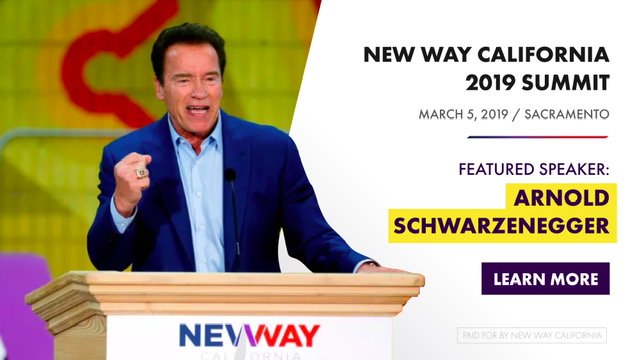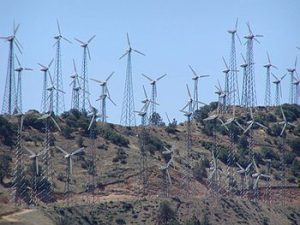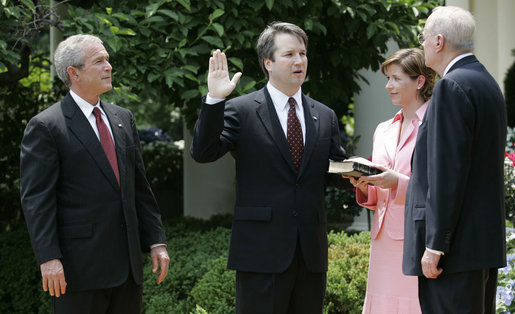
How ‘New Way California’ Can Find Its Way
Bold ideas are necessary to solve California’s challenges, and anticipated economic downturn
By Edward Ring, March 22, 2019 7:43 am
In November 2018, former Assembly Republican leader Kristin Olsen wrote a guest commentary for CalMatters entitled “GOP is dead in California. A new way must rise.” She’s right on both counts. California’s GOP is dead. And a new way must rise.
Unfortunately, the New Way California political action committee that Kristin Olsen, Chad Mayes, and Arnold Schwarzenegger have formed, at least so far, is heavy on inclusive rhetoric but short on the sort of bold policy proposals that might actually excite voters. Snippets from the NewWayCA website:
“The most durable solutions have bipartisan support.” “We will work collaboratively to advance solutions on issues that are important to all Californians.” “Not everyone has the same chance to develop their abilities.” “Often it is clear that a helping hand is needed because too many people are excluded from achieving their dreams.” “Race, religion, gender do not determine a person’s abilities or natural rights, and should not affect the way we govern.”

Bravo. These are all good thoughts. And every word of that could have come from anywhere, Right, Left, Republicans, or Democrats. It’s important to establish principles. But policies are what attract voters and change our lives. For some examples of New Way California’s policy agenda, scroll down their homepage to the “News” section, where three policy issues are highlighted. Let’s consider these one at a time.
“Bipartisan” Climate Policy
The first is entitled “Bipartisan climate policy IS possible!” The premise of this is that climate solutions should adopt a “technology neutral approach.” Sure. But if you get into specifics on technological solutions, such as issuing permits for new nuclear power plants, you’re going to hit a wall of opposition. The other objective of the article is to call attention to legislation introduced by Assemblyman Chad Mayes, the Enhanced Clean Energy Standard. It appears what this bill proposes is to (1) add yet another renewables deadline – 80 percent renewable by 2038 (currently it’s 60 percent by 2030) – and (2) allow that goal to be accomplished using a “tech-neutral” approach.
This is not original or bold, and it’s barely helpful. Sure, the concept of being technology neutral deserves repetition. But this bill ignores the most fundamental reform required for renewable energy to succeed economically, which is to require anyone selling renewable energy to a utility or other power consumer to guarantee continuous uninterrupted power, and to incorporate those costs into their pricing.
Because of this gaping loophole, utilities are forced to purchase increasing percentages of “renewable” energy at prices that only reflect the cost of, for example, building and operating a utility scale solar farm, but not the cost of constructing backup power delivery systems – natural gas “peaking” plants or, increasingly, battery farms. This means the operators of natural gas power plants have to raise their costs in order to make up for the fact that they can only produce and sell power when the sun is down or the wind falters. It also means that nuclear power plants are cut out of the market, because they cannot be turned on and off several times a day to provide load balancing for renewables. As a result, costs for natural gas and nuclear power plants are artificially inflated.
Explain that to the Democrats, Mr. Mayes. See if you can get bipartisan action. That one pricing reform would be huge progress. As it is, the spot price of electricity in California goes literally negative during moments when the entire state is bathed in sunshine, and California is now trying to force other states to buy this surplus power, which will artificially inflate their electricity prices for the same reasons.
Renewable energy* is a worthy goal, if pursued as part of a broader strategy that includes nuclear power, hydroelectric power, and as needed, clean fossil fuel. To demand wind and solar (and “tidal” and other impractical schemes), to the exclusion of all else, is an expensive, futile scam, of dubious value to the planet or anyone else apart from the vendors.
California’s Housing and Homeless Crisis
Next of the three news articles on New Way California’s website is “California’s Housing Crisis.” Apart from the rhetoric – “the old way isn’t working,” “the housing crisis and homeless crisis are bipartisan issues,” “these are complex problems that require lawmakers to put parties aside” – two specific proposals appear to have the endorsement of New Way California. One is Gov. Gavin Newsom’s push to deny transportation funds to cities that fail to meet housing requirements. The other is a bill, AB 246 (Mathis, R-Visalia), that “would authorize the Department of Transportation (Caltrans) to lease certain properties to cities and counties at a cost of $1 per month to build emergency shelters, food pantries and recreational parks.”
There are all kinds of problems with the current rush of proposals to address housing and homelessness, and as a Republican, Mayes and the rest of the New Way California gang should be coming up with more than endorsements of current proposals. Forced high-density, subsidized low-income housing, and conversion of government property to homeless shelters (examples so far are scandalously inefficient) are not enough to solve the problem. Allowing massive development of new housing on open land is the necessary corollary to these approaches. Here is a bold policy agenda to increase the supply and affordability of housing in California, and solve the homeless crisis:
(1) Eliminate all forms of government subsidies, incentives or waivers to any developers. All players in the housing industry should be unsubsidized, and playing by the same set of rules.
(2) Stop requiring diverse types of housing within the same development or neighborhood. Mixing high-density, subsidized housing into residential neighborhoods devalues the existing housing, and this social engineering is unfair to existing residents who have paid a high price to live there.
(3) Roll back the more extreme building codes. Requiring 100 percent of homes to be “energy neutral” or include rooftop photovoltaic arrays, for example, greatly increase the cost of homes.
(4) Lower the fees on building permits for new housing and housing remodels. Doing this might require pension reform, since that’s where all extra revenue goes, but until permitting costs are lower, only billionaire developers can afford to build.
(5) Speed up the permitting process. It can take years to get permits approved in California. Again, the practical effect of this failure is that only major developers can afford to build.
(6) Reform the California Environmental Quality Act (CEQA). Better yet, scrap it altogether. Federal laws already provide adequate environmental safeguards.
(7) Make it easier to extract building materials in-state. California, spectacularly rich in natural resources, has to import lumber and aggregate from as far away as Canada. This not only greatly increases construction costs, it’s hypocritical.
(8) Increase the supply of land for private development of housing. Currently only five percent of California is urbanized. There are thousands of square miles of non-farm, non critical habitat that could be opened up for massive land development.
(9) Engage in practical, appropriate zoning for infill and densification in urban cores, but only after also increasing the supply of open land for housing, and only while continuing to respect the integrity of established residential neighborhoods.
Increasing the supply of homes requires repealing or dramatically reforming CEQA, repealing SB 375, and changing the entire mentality surrounding “smart growth” and “urban containment.” It requires ending mandatory project labor agreements and legislating/litigating systemic relief from endless environmentalist lawsuits. These factors not only make home construction far more expensive than it would otherwise be, it doubles or triples the cost of constructing urban infrastructure to support new housing. California has 25,000 square miles of cattle rangeland, much of it near major interstates. Increase reservoir and aquifer storage capacity, build desalination plants along the Southern California coast, recycle all wastewater, and construct nuclear power plants, and you have all the backbone you need to provide abundant water** and power. Let the private sector build homes along the entire I-5 corridor. Widen I-5 and include hyperlanes. Watch the price of housing come down to earth.
Wildfires and Forest Management

The third article on the New Way California home page, “Wake-up, California,” is about wildfire devastation. This leads off with a recitation of the devastation of last summer’s fires, followed by accusing President Trump of “putting a roadblock on progress.” While President Trump did threaten to cut off relief for survivors, he never followed up. He was trying to pressure California’s legislature into reforming laws and policies that have caused the problem. Yes, we know, “57 percent of forest land in California is owned and managed by federal agencies.” So what? Trump wasn’t running those federal agencies for the last 30 years. And Trump’s right about forest mismanagement.
The article goes on to call these fires a “climate wake-up call.” This is opportunistic propaganda.*** Calling attention to forest mismanagement is not a “red herring,” it is the primary reason these fires became conflagrations, and better forest management is the only way disasters of similar magnitude can be avoided in the future. If New Way California wants to be “bipartisan” they can stop insulting the intelligence of anyone who has actually looked into the history of forest mismanagement over the past century, and support a comprehensive overhaul of forest management practices. Here is a consensus building approach:
Everyone agrees that aggressive fire suppression has been a mistake. Most everyone agrees that good prevention measures include forest thinning (especially around power lines), selective logging, controlled burns, and power line upgrades. And everyone agrees that residents in fire prone areas need to create defensible space and fire-harden their homes.
The New Way California “Summit”
Earlier this month, on March 5th, New Way California held a “Summit 2019” at the Crest Theatre in downtown Sacramento. The 3.5 hour event, which was live streamed, can be viewed here. The event, while featuring many interesting participants and discussing many of the important issues facing Californians, was not focused on offering specific policy recommendations.
One of the speakers, however, Pastor Samuel Rodriguez, was truly inspiring. If Rodriguez were armed with a bold policy agenda, he is the type of charismatic unifier who could run for state office in California, win, and shake things up. Another of the headliners was Bill Kristol, who should not have been invited. Kristol, a bitter, vindictive, washed up, Never-Trump RINO whose new publication is an embarrassment, was a discredit to the event, and he had absolutely nothing positive or even interesting to say. Schwarzenegger, on the other hand, offered some welcome insights.
“You don’t have to believe in global warming,” said Schwarzenegger in his inimitable accent, “but you have to believe that pollution is killing us. We’ve got to cut down the pollution, it doesn’t matter if you believe in global warming or if there’s climate change or not. Let’s assume for a second you don’t. So what? Everyone believes something different. That’s ok. But you cannot be ignorant when you go into the Central Valley and you see that kids are having asthma problems and we’re killing people with this pollution. And you can see the statistics that when people are living close to a freeway you’re more likely to die, and you die earlier. We got to do something about that and here are the ways to do it. What does this have to do with the party? There is no Republican water or Republican air, there is no Democratic water or Democratic air.”
Schwarzenegger is on to something here. Most of the things affecting our quality of life – housing, water, energy, land use, transportation – impact the environment. But if we can’t do everything to fix the environment, why not pick those projects that make sense to everyone? For reasons that are well founded and should not be suppressed, not everyone believes that anthropogenic CO2 is a serious threat to the planet. But everyone does agree that particulates make air unhealthy, and lead, arsenic, and other toxins make water unhealthy. Everyone agrees that we need to change how we manage our forests. As Schwarzenegger said, “how do we make changes and how do we do what the people really need?”
Schwarzenegger also said “It doesn’t work when one party is so far out to the Left, and one party is so far out to the Right.” He’s right. But in California the party in charge is dominated by the far Left. Discrediting the far Left, exposing the far Left, and convincing voters to abandon far Left policies and the politicians that promote them doesn’t require Trumpian vitriol, but it does require challenging many Democratic articles of faith. That in turn will arouse their fury. Here are examples of policies that challenge what the Democrats, and the special interests that support them, rely on voters to consider immutable truth. Yet despite their heretical nature, they are policies that would deliver to Californians equality of opportunity, an affordable cost of living, and economic growth distributed across all income groups.
A Bold Agenda to Resurrect California’s Republican Party
- Implement school choice with education vouchers; end war on charter schools.
- Outlaw collective bargaining for public employees.
- Enforce Vergara reforms via legislation or new litigation (dismissal, layoff, tenure).
- Cut administrative overhead at all levels of public education.
- Expand STEM and vocational education opportunities, fire the diversity bureaucracy.
- Prioritize upgrading and widening roads over rail – embrace smart roads, smart cars, and hyperlanes.
- Support public private partnerships to increase water supply – off-stream and aquifer storage, desalination, sewage reuse, runoff capture.
- Reform water markets so it’s easier for farmers to sell their allotments without losing their rights.
- Kill Delta Tunnels, upgrade levees instead and build Smelt hatchery.
- Support in-state nuclear power.
- Support in-state natural gas extraction.
- Reform renewables mandates so any supplier of renewable energy has to guarantee 365/7/24 delivery of reliable power, and include those costs in their price bids.
- Unlock open land for development.
- Repeal CEQA.
- Create a regulatory environment that encourages private investment in new housing developments instead of discouraging it.
- Require California’s public employee pension funds to invest a minimum of 10 percent of their assets in in-state infrastructure projects
- Reduce pension multipliers to pre-1999 levels for all future work for all current and new state and local employees.
- Defend the reforms of PEPRA.
Some of these ideas are more radical than others. But the intent of all of them, and their likely impact, is compassionate. It would only take a few of these policies, persuasively argued, to fundamentally transform California’s political landscape.
California is living on borrowed time. One down cycle in the cyclical high tech industry, another recession, a geopolitical change that reduces foreign investment and trade; it wouldn’t take much to derail California’s state budget surplus and throw every city and county in the state into financial chaos. Bold ideas not only are necessary to solve California’s challenges during these comparatively good times. They are what we need to be ready for the economic downturn when it comes.
New Way California is right to be advocating a less confrontational politics. But if they’re serious about helping the Republican Party come back in California, and if they really want to “do what the people really need,” they also have to promote policies that put them sharply at odds with the conventional political wisdom and prevailing special interests. They have to find politicians who can express these rebellious heresies in ways that keep people listening. And then, once people are listening, they will need to have the courage to follow through.
*For more information on the true cost of solar energy, read California’s “Renewables Mandate Sets an Impossible Example for the World,” and “What Would It Cost America to ‘Go Solar’?”
**For much more on how to create water abundance in California, read “Towards a Grand Bargain on California Water Policy.” For more on desalination, read “Rebuilding California’s Infrastructure – Desalination,” and for more on transportation policy, read “California’s Transportation Future – Next Generation Vehicles.”
***For much more on how overwrought climate change rhetoric is being used to replace flawed policies of the past with even more flawed policies for the future, read “How the Greens Turned the Golden State Brown.”
- Ringside: Will the Delta Pumps Operate at Capacity this Winter? - December 18, 2025
- Ringside: Will Advocates for More Water Supply Projects Find Unity? - December 11, 2025
- Ringside: EVs and California’s Future Demand for Electricity - December 4, 2025





Mr. Ring, I appreciate that you wrote about “New Way California,” the most recent group of curious people to call themselves reformers (as I recall the 2012 version was called “California Forward” or “Go Long” or some such nonsense) as a contrast to your own list of very necessary proposals that the CAGOP must embrace to rebuild the party.
On the subject of homelessness, I hope you will take a look at this excellent documentary, “Seattle is Dying.” It is serious and fact-based and tells a story of bad (Democrat) policy that is common to all of our west coast big cities. I’m not sure the housing reforms you listed, which I agree are absolutely necessary and would make housing more affordable, would solve the kinds of problems one sees here. I appreciate this video because it provides solutions in addition to documenting the problems. Thank you very much for your good work.
“Seattle is Dying” (KOMO News)
https://www.youtube.com/watch?v=bpAi70WWBlw